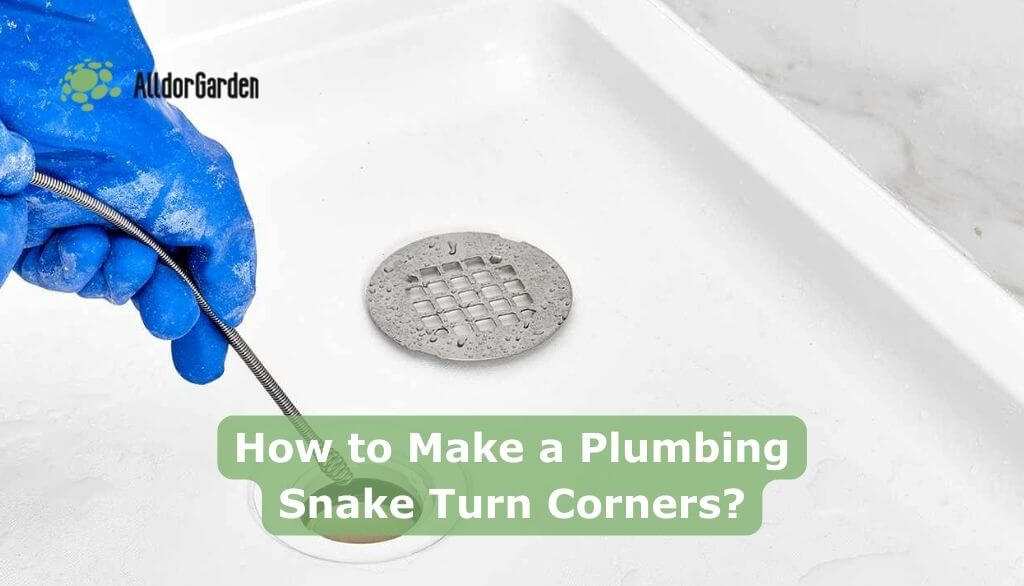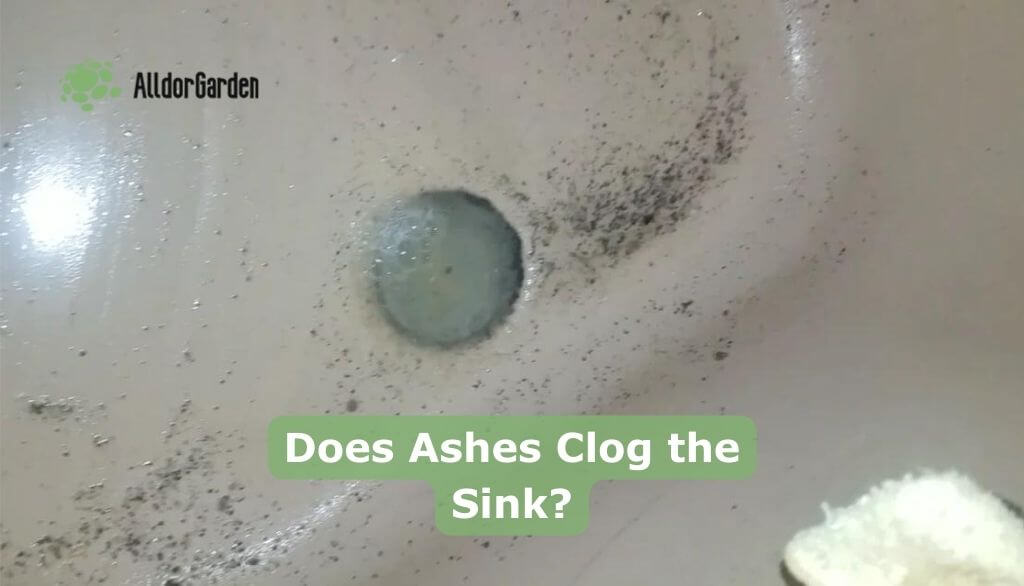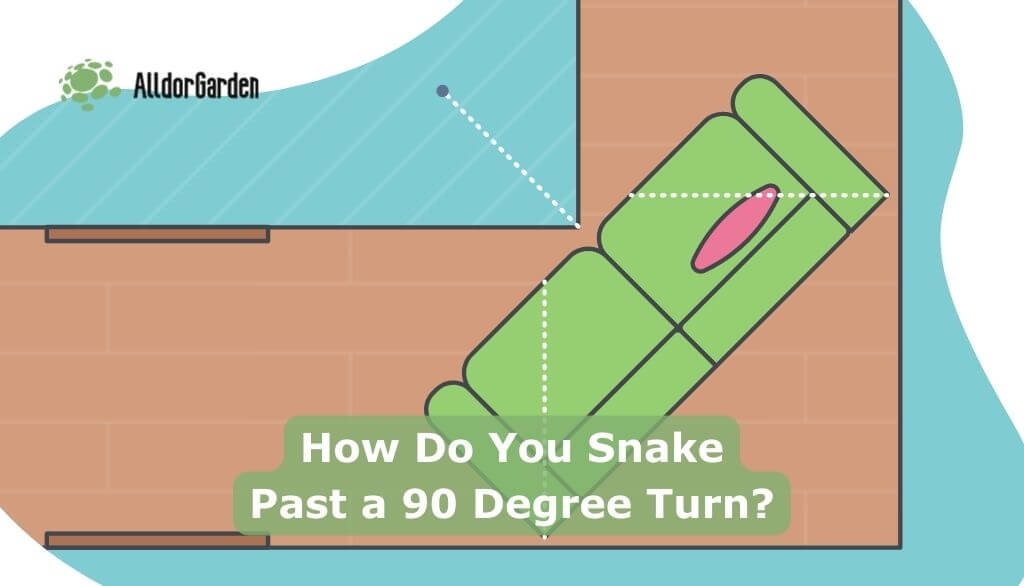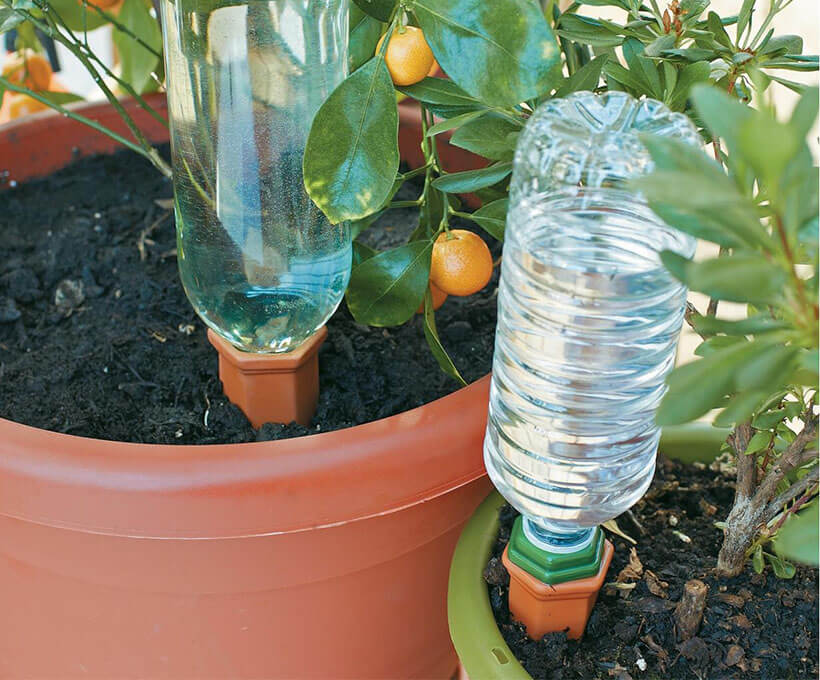Plumbing snakes are a handy tool for clearing clogs and blockages in your pipes, but navigating around corners can be tricky. Making a plumbing snake turn corners requires a bit of finesse, but with the right technique, you can successfully clear your pipes without causing damage. In this post, we’ll explore how to make a plumbing snake turn corners.

What Is a Plumbing Snake?
Plumbing snakes, also known as drain snakes or augers, are a common tool used to clear clogs and blockages in pipes. There are several types of plumbing snakes available, each with their own unique features and uses.
The most common types of plumbing snakes include:
- Handheld snakes: These are the most basic type of plumbing snake, consisting of a long, flexible cable with a hook or auger on the end that’s used to break up and clear blockages.
- Closet augers: These are specialized snakes designed specifically for clearing clogs in toilets. They have a protective sleeve that prevents them from scratching the porcelain surface of the toilet.
- Electric snakes: These are powered by electricity and are typically used for larger, more stubborn blockages. They are more expensive than handheld snakes, but can be more effective.
- Jetting machines: These are high-powered machines that use water pressure to clear blockages from pipes. They are typically used by professional plumbers for more serious blockages.
When it comes to using a plumbing snake, the first step is to identify the type and location of the blockage. Handheld snakes are typically effective for smaller blockages, while electric snakes or jetting machines may be necessary for more serious clogs.
It’s important to use the right type of snake for the job, as using the wrong type can cause damage to the pipes or make the blockage worse. It’s also important to follow safety precautions, such as wearing gloves and eye protection, and to avoid using too much force or pulling too hard on the snake.
Why Turning Corners With a Plumbing Snake Can Be Tricky?
When it comes to clearing clogs and blockages in pipes, turning corners can be one of the most challenging tasks.
One of the main reasons why turning corners with a plumbing snake can be tricky is that the snake can get stuck or tangled in the pipes. This can cause damage to the pipes or make the blockage worse, resulting in a more serious plumbing issue.
Another common issue when turning corners with a plumbing snake is the risk of causing damage to the pipes. Pulling too hard or using too much force can cause the snake to break, which can cause the blockage to become more compacted or even damage the pipes themselves.
To avoid these issues when turning corners with a plumbing snake, it’s important to take a careful and patient approach.
How to Make a Plumbing Snake Turn Corners: A Step-by-Step Guide
Plumbing snakes are a handy tool for clearing clogs and blockages in your pipes, but navigating around corners can be tricky. Making a plumbing snake turn corners requires a bit of finesse, but with the right technique, you can successfully clear your pipes without causing damage.
The proper way to use a snake is to insert the head into the drain and push very slowly without cranking. If you try to force it, it can bend back on itself and actually come out of the drain. Push gently and slowly, and if the auger is the right one for the job, it should slide smoothly through the pipe.
Step 1: Insert the snake
Insert the plumbing snake into the pipe and slowly guide it towards the blockage. It’s important to go slowly and carefully to avoid causing damage to the pipes.
Step 2: Turn the handle
As you approach a corner, turn the handle of the plumbing snake to maneuver around the bend. Avoid using too much force or pulling too hard, as this can cause the snake to break or damage the pipes.
Step 3: Wiggle the snake
Gently wiggle the plumbing snake back and forth to navigate around the bend. This can help dislodge the blockage and clear the pipes.
Step 4: Avoid obstacles
If you encounter an obstacle, such as a joint or valve, carefully maneuver the snake around it. Be patient and take your time to avoid causing damage.
Step 5: Use a camera attachment
If you’re having trouble seeing what’s inside the pipes, consider using a camera attachment to get a visual. This can help you navigate around corners more easily and avoid obstacles.
Step 6: Remove the blockage
Once you’ve navigated around the corner and reached the blockage, use the plumbing snake to break it up and clear it from the pipes. Be careful not to use too much force, as this can cause the blockage to become more compacted.
By following these steps and best practices, you can successfully navigate around corners with a plumbing snake and clear your pipes without causing damage or making the blockage worse. Remember to use the right type of snake for the job, go slow and steady, and avoid using too much force. If you’re having trouble clearing the blockage, consider calling a professional plumber for assistance.

How To Use A Plumbing Snake To Unclog Any Drain? Youtube Video
Tools for Successfully Snaking Around Corners
When it comes to snaking around corners with a plumbing snake, having the right tools and equipment can make the job much easier and more effective. Specialized attachments and cameras can provide a visual of what’s inside the pipes and help you navigate around bends and obstacles more easily.
Camera attachments can be a game changer when it comes to snaking around corners. These devices attach to the end of the plumbing snake and provide a visual of what’s inside the pipes. This can help you avoid obstacles and maneuver around bends more easily.
Flexible augers are a type of attachment that can be added to the end of a plumbing snake. They are designed to bend and flex around corners and can be helpful for clearing blockages in narrow or hard-to-reach spaces.
Jetting machines use high-pressure water to clear blockages from pipes. They are typically used by professional plumbers for more serious blockages but can be helpful for snaking around corners in certain situations.
Gloves and eye protection: When using a plumbing snake, it’s important to protect your hands and eyes from any debris or chemicals that may come out of the pipes. Be sure to wear gloves and eye protection to avoid injury.
Common Mistakes to Avoid When Snaking Around Corners
Snaking around corners with a plumbing snake can be a tricky task, and there are a few common mistakes that people often make that can lead to damage or make the blockage worse.
Using too much force
One of the most common mistakes people make when snaking around corners is using too much force. Pulling too hard on the snake or using excessive force can cause the snake to break or damage the pipes.
Tip: Be patient and go slow and steady when navigating around corners. Avoid using too much force, and gently wiggle the snake back and forth to maneuver around bends.
Not being patient enough
Another common mistake people make when snaking around corners is not being patient enough. It can take time to clear a blockage, and rushing the process can lead to mistakes or damage.
Tip: Take your time and be patient when snaking around corners. Remember that it’s better to go slowly and get the job done right than to rush and cause damage.
Using the wrong type of snake
Using the wrong type of snake for the job can also be a common mistake. Different types of snakes are designed for different types of pipes and blockages, and using the wrong type can cause damage or make the blockage worse.
Tip: Choose the right type of snake for the job based on the size and type of pipes you’re working with. If you’re not sure which type of snake to use, consult a professional plumber.
Not using safety precautions
Not using safety precautions when snaking around corners can also be a common mistake. It’s important to protect your hands and eyes from any debris or chemicals that may come out of the pipes.
Tip: Wear gloves and eye protection when using a plumbing snake to avoid injury. Follow all safety precautions recommended by the manufacturer.
By avoiding these common mistakes and following the tips provided, you can successfully navigate around corners with a plumbing snake and clear blockages from your pipes more easily.
Tips for Protecting Yourself When Using a Plumbing Snake
When using a plumbing snake to clear clogs and blockages from your pipes, safety should always be a top priority. There are several potential hazards associated with using a plumbing snake, including exposure to hazardous materials such as sewage and the risk of injury from the snake itself.
Wear gloves and eye protection
When using a plumbing snake, it’s important to protect your hands and eyes from any debris or chemicals that may come out of the pipes. Wear gloves and eye protection to avoid injury.
Avoid contact with hazardous materials
Plumbing snakes are often used to clear blockages that may contain sewage or other hazardous materials. Avoid contact with these materials by wearing gloves and other protective gear, and dispose of any waste materials properly.
Follow safety precautions recommended by the manufacturer
Different types of plumbing snakes may have different safety precautions recommended by the manufacturer. Be sure to read and follow all safety instructions carefully to avoid injury.
Handle the snake carefully
When handling the plumbing snake, be careful not to pull too hard or use too much force. This can cause the snake to break or damage the pipes.
Call a professional plumber if necessary
If you’re not confident in your ability to use a plumbing snake safely, or if you encounter a particularly stubborn blockage, consider calling a professional plumber for assistance. They have the expertise and equipment to handle even the most difficult clogs and can help you avoid injury or damage to your pipes.
What to Do If the Plumbing Snake Gets Stuck or If the Blockage Cannot Be Cleared by Snaking Alone?
While snaking around corners with a plumbing snake can be an effective way to clear clogs and blockages from your pipes, sometimes things don’t go as planned. The snake can get stuck or the blockage may be too stubborn to clear with snaking alone.
What to do if the plumbing snake gets stuck?
If the plumbing snake gets stuck, it’s important to avoid pulling too hard or using too much force, as this can cause damage to the pipes. Instead, try gently wiggling the snake back and forth to loosen it. If this doesn’t work, consider calling a professional plumber for assistance.
What to do if the blockage cannot be cleared by snaking alone?
If the blockage cannot be cleared by snaking alone, there are a few other things you can try. First, try using a plunger to create suction and dislodge the blockage. If this doesn’t work, consider using a chemical drain cleaner, although be aware that these can be harmful to your pipes and should be used with caution. If none of these methods work, it may be time to call a professional plumber for assistance.
When to call a professional plumber?
If you’re not confident in your ability to use a plumbing snake safely, or if you encounter a particularly stubborn blockage, it’s always a good idea to call a professional plumber for assistance. They have the expertise and equipment to handle even the most difficult clogs and can help you avoid injury or damage to your pipes.
Keeping Your Plumbing Snake in Good Condition
A plumbing snake is an essential tool for clearing clogs and blockages from your pipes, and with proper maintenance and care, it can last for years.
Clean the snake after each use
After using your plumbing snake, be sure to clean it thoroughly to remove any debris or chemicals that may have accumulated on it. Use a clean cloth or paper towel to wipe down the snake, and clean any attachments or accessories as well.
Store the snake properly
When not in use, store your plumbing snake in a dry, cool place to prevent rust or corrosion. Avoid storing it in direct sunlight or in an area where it may be exposed to moisture.
Check for damage regularly
Regularly inspect your plumbing snake for signs of damage, such as cracks or breaks in the cable. If you notice any damage, stop using the snake immediately and have it repaired or replaced.
Lubricate the cable
Occasionally lubricate the cable of your plumbing snake with a silicone-based lubricant. This can help prevent rust and make it easier to maneuver around corners and bends.
Use the right type of snake for the job
Using the right type of snake for the job can also help prolong the life of your plumbing snake. Different types of snakes are designed for different types of pipes and blockages, so be sure to choose the right one for the job.
Real-Life Examples of Successfully Snaking Around Corners
We’ll share real-life examples of successful snaking around corners to inspire and inform your next plumbing project.
Clearing a stubborn blockage in a kitchen sink
A homeowner in a suburban area was experiencing a stubborn blockage in their kitchen sink. The water was draining slowly and backing up into the sink. After attempting to clear the blockage with a plunger and chemical drain cleaners, they decided to try snaking around corners. With patience and a gentle touch, they were able to navigate the snake around the corners and dislodge the blockage. The sink was draining smoothly again, and the homeowner avoided the expense of calling a professional plumber.
Clearing a clog in a bathroom shower
A renter in an apartment building noticed that the water in their shower was draining slowly and eventually stopped draining altogether. After attempting to clear the blockage with a plunger, they decided to try snaking around corners. With a camera attachment, they were able to navigate the snake around the corners and identify the blockage – a clump of hair and soap scum. After clearing the blockage, the shower was draining smoothly again, and the renter avoided the hassle of calling their landlord or a professional plumber.
Clearing a blockage in a commercial kitchen
A restaurant owner noticed that the water in their sinks and dishwashers was draining slowly and eventually backing up. After attempting to clear the blockage with chemical drain cleaners, they decided to try snaking around corners. With a flexible auger attachment, they were able to navigate the snake around the corners and dislodge the blockage, which turned out to be a buildup of grease and food particles. With the sinks and dishwashers draining smoothly again, the restaurant was able to avoid costly downtime and lost business.
By taking a careful and patient approach, and using the right tools and equipment, these homeowners and business owners were able to successfully snake around corners and clear blockages from their pipes.
Choosing the Right Type of Snake and Equipment
Choosing the right type of snake and equipment for a plumbing project can make all the difference in its success. Different types of blockages and pipes require different types of equipment and techniques.
Blockages in kitchen sinks and bathroom drains
For blockages in kitchen sinks and bathroom drains, a medium-duty hand-crank snake is often the best choice. These snakes are typically around 25 feet long and can be maneuvered around corners and bends with ease. They’re also easy to use and relatively inexpensive.
Clogs in toilets
For clogs in toilets, a toilet auger is typically the best choice. These augers are designed specifically for use in toilets and can easily navigate around the curves of the toilet bowl. They’re also relatively inexpensive and easy to use.
Blockages in main sewer lines
For blockages in main sewer lines, a heavy-duty motorized snake is often the best choice. These snakes are typically several hundred feet long and can easily navigate through the larger pipes of a main sewer line. They’re also powerful enough to clear even the most stubborn blockages.
Snaking around corners
When snaking around corners, a camera attachment can be a valuable tool. These attachments provide a visual of what’s inside the pipes and can help you avoid obstacles and maneuver around bends more easily. Flexible augers are also a good choice for snaking around corners, as they can bend and flex to navigate through narrow or hard-to-reach spaces.
By choosing the right type of snake and equipment for the job, you can increase your chances of success and avoid damaging your pipes or equipment.
FAQs
Why Won’t My Drain Snake Turn Corners?
How Do You Get a Drain Snake Around the Corner?
How Do You Spin a Drain Snake?
How Do You Unclog a Drain if a Snake Doesn’t Work?
Conclusion
Snaking around corners with a plumbing snake can be a challenging task, but with the right technique and approach, it can be accomplished successfully.
To make a plumbing snake turn corners, it’s important to be patient and go slow and steady. Avoid using too much force, and gently wiggle the snake back and forth to maneuver around bends.
Using a flexible auger or camera attachment can also be helpful for navigating through narrow or hard-to-reach spaces. Remember to choose the right type of snake for the job and follow the manufacturer’s instructions carefully.
By taking a careful and patient approach, you can successfully navigate around corners with a plumbing snake and clear blockages from your pipes more easily.
If you’re having trouble snaking around corners or clearing a blockage, consider calling a professional plumber for assistance. They have the expertise and equipment to handle even the most stubborn clogs and can help you avoid costly repairs and damage to your pipes.




